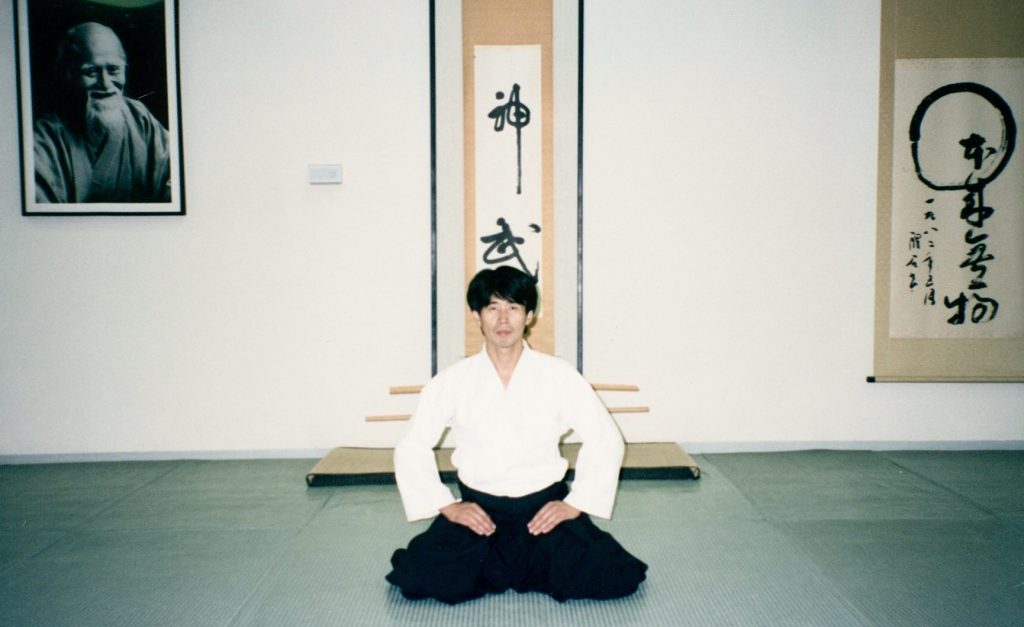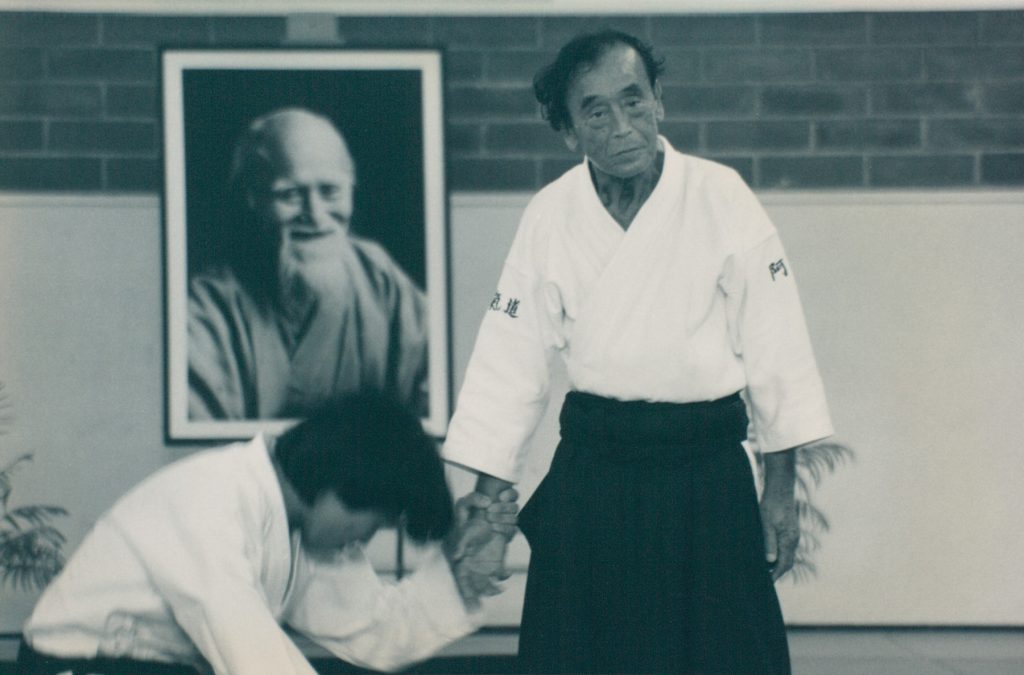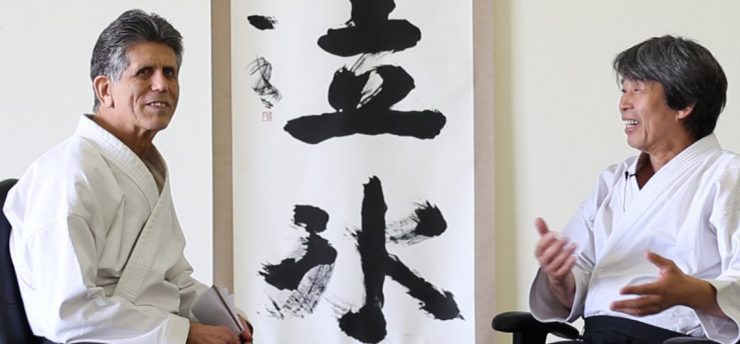This is part 2 of a discussion series with Haruo Matsuoka Sensei and Stan Pranin Sensei. In this segment, Matsuoka Sensei talks about seeking new mentors and the insight and inspiration he’s gained from these great masters. For Part 1, read here; for Part 3, read here.
Pranin: Sensei, when did you become independent, you said in 1998?
Matsuoka: Yes. That’s when I went back to Japan.

Yes. How did you find that your Aikido changed? And what were you thinking about? What changed in your mind and why did you take your Aikido in a different direction?
Mostly, when I left my mentor, some weird feelings came up.
Loneliness maybe?
A kind of loneliness. Yes, that’s one thing. Then I felt also at the same time some kind of limitation with my ability. I didn’t know how to improve myself without a mentor. But almost immediately I chose Abe Sensei as my new mentor. He encouraged me.
What was Abe Sensei’s influence in your technique? What did he want to explain to you or what direction did he want you to follow? What are the things that you learned from him technically?
Simply speaking, kokyu. How to connect to the opponent. I never paid enough attention to that before.
For people who don’t know Japanese, or they don’t know what kokyu means, the literal meaning, of course, is breathing. Certainly the idea of kokyu includes breath and control of breath.
Yes, it took me a while to understand kokyu. I’m still seeking of course. I will probably be studying the concept eternally until I die to keep seeking. I still don’t have the answers. However, one way I think about kokyu is to use my whole body in a single moment. This is more understandable to me.

Through Abe Sensei, I realized how much I did not understand before. That’s why I felt so limited… my abilities were so limited. Really I hit the wall completely. So that’s why in this regard Abe Sensei gave me encouragement to seek a different way to cultivate my abilities.
You talked about the importance of physical touching and hand-to-hand contact. I found that with a point of connection between two people, there’s literally a transfer of energy going in both directions. I think that through a lot of practice you can learn to read and understand your partner’s physical movements.
Sometimes it doesn’t sound realistic, but actually to me it’s very realistic.
This morning when I was talking with the Ikazuchi Dojo instructors, I was just explaining to some of the teachers that if you grab someone’s hand and they react in certain ways; you can read changes in the forearm. You have some information about what they’re going to do, when they’re going to do it, what direction they will move, etc. This is because you literally have a physical connection. Of course, there may be a spiritual dimension too, but there’s that physical contact.
But on the other hand, when we are seeking movement, it is almost like the physical body and spiritual condition are two sides of one coin.
Yes, indeed.
No matter how you move, it’s linked to your spiritual condition. This is still very hard to figure out. I remember when Abe Sensei would teach, it really didn’t look like a move; there’s no technique. But there’s something that caused me to go down in a single moment. What was that? Every day, I’m still thinking about that.

A unified body connected from hand to hand leads to balance breaking, taking the balance.
Hand to hand, right. I’ve had numerous teachers, very good people who expressed this differently, but it’s the same principle. I can’t say it’s exactly the same, but the essence is the same. This helps me to confirm my focus, my journey.
Yes, absolutely. We’ve had a chance to talk for several hours this week. I know you’ve had a lot of contact with Yoshinori Kono Sensei too. When I lived in Japan, the last part of my stay there. I had regular contact with him. Can you talk about the influence of Kono Sensei and maybe some other martial artists that have had a strong impact on you?

It was November 24th and 25th, two days in 2004, the first time that I visited Kono Sensei and the first time I had hand-to-hand contact. I felt something different. So that actually made an impression on me. He explained that if we can take many different parts of the body and coordinate them in a single moment, tremendous power can be created. I never thought that way.
Then, I started really technically seeking the essence of this idea. I started pushing myself. This is how I started a new journey, and Kono Sensei showed me technically how to move in that direction.
This area that we’re in right now, Southern California, in some senses is a mecca of martial artists. Of course, many action movies are filmed here. You were talking last night about having contact with Dan Inosanto, the student of Bruce Lee. Can you tell us how that meeting came about, what he’s like as a person, and what you learn from spending time with him?
Yes of course. He’s much older and more experienced than me in the world of martial arts, so I really have a great respect for him and his history. I first had the opportunity to meet him in the early 1990s on a movie set.
Wow!

So this is how we met. I also met his student Jeff Imada in the early 1990s. He became a friend. A few years ago, I actually started having more of a friendship and I was very interested in this relationship because of the potential information exchange. This is very important since I lost Abe Sensei, my mentor. I have to find ways to figure things out and move forward. I’m looking for some instructors, some experts to touch, to learn from. I’m determined to do this. Through this viewpoint I found Kono Sensei, Yamaki Sensei (Kyokushin Karate World Champion) and Guro (Sensei) Dan Inosanto in the same way. This way I get inspiration and can continue on my journey. And in regards to Dan Inosanto, I’m very curious about the Filipino martial arts, because of their different mentality and differences compared to Japanese martial arts. It’s amazing to train with him because he’s so humble, I mean too humble. I mean really for me it’s very scary!
You were mentioning that he seems to have such a beginner’s mind, even though he’s 80, or almost 80.
He’s amazing. He is my inspiration and this is one of the most valuable points I’ve learned from him.
In Part 3 of the discussion series, Matsuoka Sensei and Pranin Sensei share insights and experiences with internal power generation, body structure, and the essence of the power of aiki.













Always be learning! Remain humble! It’s when you think you know it all that you really know nothing. Admitting to knowing nothing, is the beginning of knowing. Be a seeker truth. Truth exists “within and without you” parlaying some George Harrison. When the student is ready, the teacher appears! Respect! OSSU! Peace!